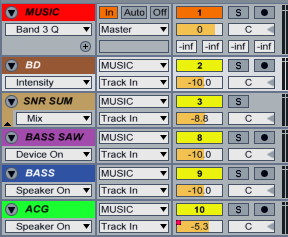How to mix vocals and music? This is probably one of the most frequently asked questions after "how to mix music in general." I'm sure that by using my little piece of advice you will surely take a step forward in quality of your next mixes.
So, to make it simple, the finished mix should be perceived as a layered instrument where each of the sounds is arranged in a way that it doesn’t impede the other ones. And of course, it should perform its main task too! So at audio mixing and mastering, music serves as a base to the vocals, and it means that we need some procedures so that the music gives support to the voice, but does not clash with its basic frequencies. Mid-Side equalization is going to help us with this task.

I send the mix instruments to a separate AUX bus very often. They can be either almost all of the elements, except the leading vocals, or the elected ones – as a rule, the main ones (Kick, Snare, Keys etc.)
At the next stage of mixing vocals to an instrumental I place on the AUX bus any digital equalizer that operates in the Mid-Side mode. I personally prefer Pro Q2 from Fabfilter. But it's not that important – use any other equalizer that's convenient for you. Even a stock EQ, available in your DAW, can do this task. The main thing is a possibility of working with the EQ separately in the Mid and Side channels.

Now all that is required is to make 1 to 3 cuts with bell EQ in the Mid channel in the upper mids (Q is 4 to 6, attenuation is about 1.5 to 3dB) to eliminate the conflict. This is important! Of course, the main source of conflict of frequencies with vocals is Snare (or Clap)! But when applied to all the other instruments of the mix, this trick will give exactly that subtle feeling of better separation of vocals and music in space.
Apply this trick at the very beginning of your work with a project, and mixing vocals with music will be a lot easier!
Depending on the situation, this method can be supplemented or replaced by using a multiband compressor set to suppress the frequencies in music responsible for vividness and clarity of the vocals in the mix. Install this type of compressor on the AUX bus. Create a copy of the track with the main vocal (to save the CPU you can remove all the processing from it except compression) and use it as a trigger for the compressor running in the sidechain mode. So that the work of the compressor is not obvious, limit its range of Gain reduction around 1.5 to 3dB.
Any of these ways will make mixing vocals to music a whole lot easier!
RECOMMENDED ARTICLES:
- HOW TO RECORD VOCALS ON CELL PHONE
- HOW TO MIX RAP VOCALS ONTO AN INSTRUMENTAL
- HOW TO MIX RAP AND HIP-HOP VOCALS: PREPARATION
- HOW TO MIX RAP AND HIP-HOP VOCALS: COMPRESSION, EQ AND DE-ESSING
Any specific topic that you'd want to learn about?
Any other questions?
Feel free to ask - I'd love to help!
